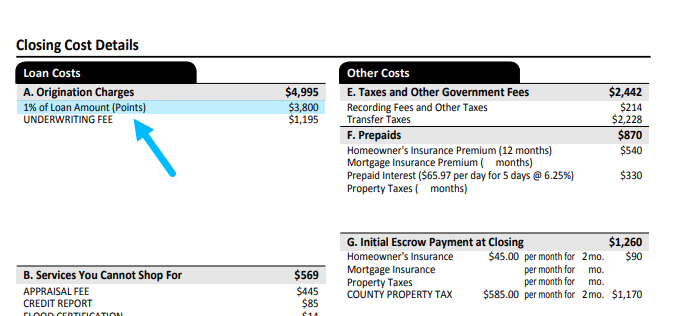Mortgage discount points are an optional upfront fee you pay at closing to lower your interest rate.
Paying points lets you “buy down” the rate, which reduces your monthly payment and the total interest you’ll pay over the life of the loan.
This only works if you keep the home long enough to recover the upfront cost. For most Chicago homebuyers, paying points doesn’t make sense, and I’ll explain why in this article.
How to calculate the cost and savings of points
Lenders calculate points as a percentage of your loan amount:
1 discount point = 1% of the loan amount.
In exchange, the lender lowers your interest rate. The reduction varies, but a common estimate is 0.25% per point.
Laura is buying a $400,000 condo in Chicago’s West Town neighborhood with a $380,000 loan.
Her current rate is 6.5% with no points.
She can lower it to 6.25% by paying 1 point, which costs $3,800 (1% of the loan amount).
Using Laura’s $380,000, 30-year fixed loan, the table below compares the upfront cost of points to the monthly payment savings.
|
Rate
|
Points
|
Upfront Cost
|
Monthly Payment
|
| 6.50% |
0% |
$0.00 |
$2,402 |
| 6.25% |
1% |
$3,800 |
$2,340 |
| |
Cost: $3,800 |
Savings: $62 |
By paying $3,800 for one point, Laura would reduce her monthly payment by $62. While the savings accumulate, the key is knowing how long it takes to recoup the upfront cost.
What is the break-even point for mortgage discount points?
The break-even point for mortgage discount points is the time it takes for your monthly savings from the lower interest rate to equal the upfront cost you paid for the points.
Mortgage discount points break-even formula:
- Points paid at closing
- ÷ Monthly savings
- = Months to break even
For Laura:
$3,800 (points paid at closing) ÷ $62 (monthly savings) = 61 months to break even, or about 5 years.
If she stays in the condo longer than 5 years, buying the point makes financial sense. Every month after that is pure savings.
Get a side-by-side comparison of rates with and without points. Our real-time calculator shows you today's rates and closing costs instantly, giving you the transparency you need to plan your purchase.
Mortgage Discount Points Calculator
Find out how long it will take to recover the upfront cost of discount points through your monthly payment savings. This helps you decide if buying points is worth it for your loan.
Should you pay points?
Use this table to help you decide if paying for points aligns with your homeownership goals.
|
Consider Paying Points If...
|
Don't Pay Points If...
|
|
You plan to stay in the home long-term. You will keep the loan long enough to break even and enjoy the savings.
|
You might move or refinance soon. You may sell or refinance before you recoup the upfront cost of the points.
|
|
You have extra cash. You can comfortably afford the points on top of your down payment and closing costs.
|
Cash is tight. The money for points could be better used for moving expenses, an emergency fund, or furniture.
|
|
You have a fixed-rate mortgage. Your rate and payment are set for the life of the loan.
|
You have an adjustable-rate mortgage (ARM). Your rate will change, which may happen before you break even.
|
|
You have a down payment of 20% or more. You are not paying for private mortgage insurance (PMI).
|
Your down payment is less than 20%. Use extra funds to increase your down payment to avoid or cancel PMI sooner.
|
For most Chicago first-time buyers, paying mortgage discount points doesn’t make sense because they usually sell or refinance within five years, often before reaching the break-even point.
Many also make small down payments (5-10%), which means that extra cash is better spent on reducing mortgage insurance costs or keeping more money in reserve for maintenance, furniture, and emergencies.
Schedule a time to talk with a mortgage expert at NewCastle Home Loans. We will provide you with today's rate, both with and without points, to help you determine if buying down the interest rate is worthwhile.
Do lenders ever require discount points?
Some lenders require points on riskier loans. A lender might require you to pay points if your application includes a combination of factors like:
-
Low credit scores
-
Small down payments
-
Second homes or investment properties
-
Condos or 2–4 unit properties
-
Loans with second mortgages
Let's say you have a low credit score of 620 and apply for a conventional mortgage to buy a 2-unit property with 15% down payment.
In this case, the lender might require you to pay discount points to offset the risk.
You can ask the seller to cover your discount points or other closing costs to reduce your out-of-pocket expenses. For more information, read our guide on seller credits.
Where to find points on your Loan Estimate
Points appear on page 2 of the Loan Estimate, Section A: Origination Charges.
This line item includes both optional points you choose to pay and any points required by the lender.

Compare Loan Estimates from different lenders by looking at both the rate and the total origination charges, not just one or the other.
View your rate and closing costs, including discount points, on our mortgage calculator. You'll feel better knowing the exact cost of a home.
Additional info about mortgage discount points
You can trust the following sources for more information about mortgage discount points.






